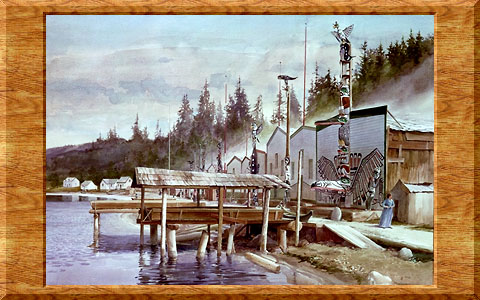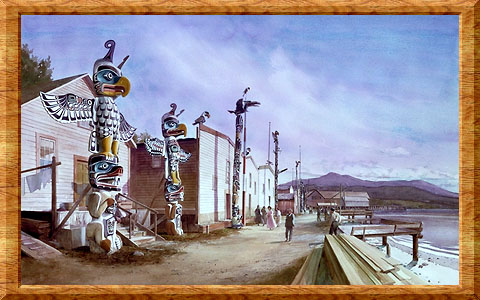
Original watercolour 27" x 39" by Gordon Miller © 1986
The village of Alert Bay faces south-west along a wide beach on Cormorant Island at the northern end of Johnston Strait. The bay and the island were both named after British naval vessels surveying in the area in the 1840s and '50s. The Kwakwaka'wakw name is Ya'Lis meaning "spreading-leg beach".
The region occupied by the Kwakwaka'wakw -- the northern end of Vancouver Island, the mainland opposite, and the islands between -- were rich in sea life and heavily forested. At some time between 1865 and 1870 a Mr. Spencer and a Mr. Huson leased land on Cormorant Island from the government and built a small saltery there. To ensure a larger pool of labour, they persuaded the 'Namgis band from the Vancouver Island shore opposite to resettle in Alert Bay. They also built a mission house, and the Reverend Alfred James Hall from the Church Missionary Society of Fort Rupert took up residence in 1878. This society built a church in 1881 and started a sawmill in 1887. A school was opened in 1899 and by the beginning of the century Alert Bay had become the primary trading centre on the coast between Campbell River and Prince Rupert. Today it continues to be the centre of art and culture of the Kwakwaka'wakw people.
This view of Alert Bay is looking north from the site of the original cannery. The first pole, called the Wakas Pole after the chief who owned it, stood for many years in Stanley Park in Vancouver. It has been given on extended loan to the Canadian Museum of Civilization, which has replaced it in Vancouver with a newly carved replica.

Original watercolour 24" x 40" by Gordon Miller © 1986
The earliest photographs show about a dozen traditional Kwakwaka'wakw cedar plank houses along the beach, with one or two painted fronts but no carved totem poles. After the sawmill started operations, the houses began to be covered with milled siding. About 1900 there was a sudden surge of pole raising activity in front of the Kwakwaka'wakw houses. At this time two of the finest Kwakwaka'wakw carvers, Charlie James and Mungo Martin, were carving in the village and actively engaged in preserving and continuing the vigorous Kwakwaka'wakw culture.
This view is of the Native houses looking south. The two Thunderbirds on the foreground poles represent a very important and powerful sky-being in the mythology. Thunder and lightning were said to accompany Thunderbird's flight, and he could lift heavy house beams and set them in place. Supernatural horns on his head, curved and massive upper beak and emphasized talons are his distinguishing features. The nearest tall pole seen in the picture, "Raven-of-the-Sea", was carved by Mungo Martin in 1902, and is now in the Museum of Anthropology at the University of British Columbia.